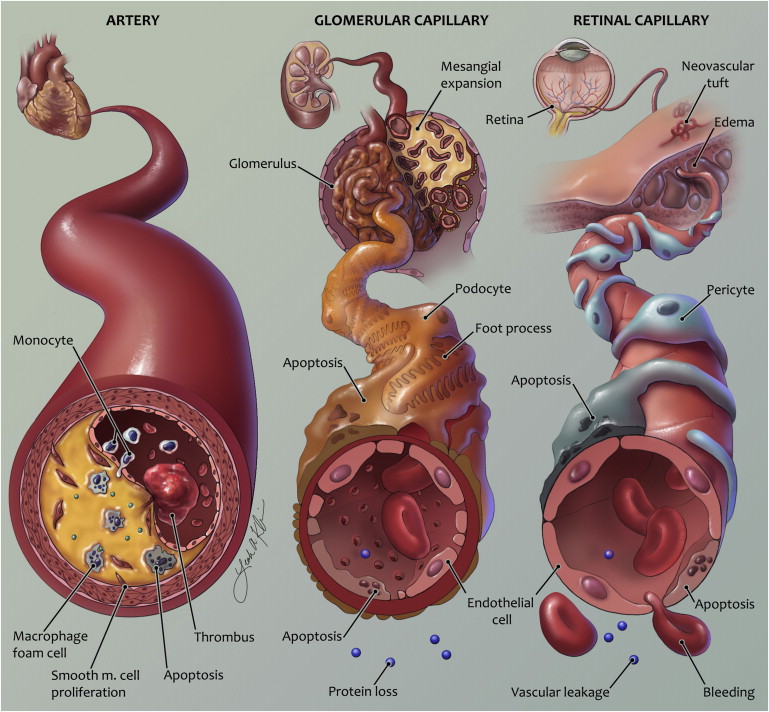
Diabetes is a global health crisis, affecting millions worldwide. Diabetes mellitus can lead to severe complications, such as macrovascular problems, which can be life-threatening. Researchers have now discovered a novel approach to identify individuals at high risk of developing these complications, by examining the levels of certain genetic molecules called long non-coding RNAs (lncRNAs) and microRNAs (miRNAs). This groundbreaking research could pave the way for early diagnosis and targeted treatment of diabetic vascular complications, ultimately improving the quality of life for those living with this chronic condition.
The Diabetes Epidemic and its Devastating Consequences
Diabetes is a rapidly growing global health crisis, with an estimated 10.9 million people affected in Egypt alone. This number is expected to rise to 13 million by 2030 and 20 million by 2045, making Egypt one of the countries with the highest prevalence of diabetes worldwide. Uncontrolled diabetes can lead to a range of severe complications, including macrovascular problems that affect the heart, brain, and legs, as well as microvascular issues that can damage the eyes, kidneys, and nerves.
Cardiovascular disease and stroke are responsible for a staggering 50% of deaths in individuals with diabetes, making the early detection and prevention of these macrovascular complications a critical priority. Understanding the underlying molecular mechanisms that contribute to the development of these complications is essential for developing effective strategies to mitigate their devastating effects.
Uncovering the Genetic Signatures of Diabetic Vascular Complications
Researchers have recently discovered that certain genetic molecules, known as long non-coding RNAs (lncRNAs) and microRNAs (miRNAs), play a crucial role in the development of diabetic vascular complications. These non-coding RNAs, which do not directly encode proteins, can still significantly influence the expression of other genes and contribute to the complex mechanisms underlying disease pathogenesis.
One particular lncRNA, called LYPLAL1, has been found to have a protective effect against the development of diabetic macrovascular complications. This lncRNA appears to work by regulating the levels of miR-204-5p and the protein SIRT1, both of which are involved in the inflammatory and oxidative stress pathways that can lead to vascular damage in diabetes.
Leveraging Genetic Biomarkers for Early Detection and Risk Assessment
The research team set out to investigate the potential of these genetic markers, LYPLAL1, miR-204-5p, and SIRT1, as diagnostic tools for identifying individuals at high risk of developing diabetic macrovascular complications. By comparing the levels of these markers in individuals with diabetes, both with and without macrovascular complications, the researchers were able to make some remarkable discoveries.
They found that the levels of LYPLAL1 and SIRT1 were significantly lower in those with macrovascular complications, while the levels of miR-204-5p were significantly higher. Interestingly, the lncRNA LYPLAL1 demonstrated the best performance in detecting macrovascular complications, with an impressive 96.9% sensitivity and 90.6% specificity.
Furthermore, the combined use of all three markers (LYPLAL1, miR-204-5p, and SIRT1) yielded the highest accuracy, reaching an impressive 98.4% in predicting the risk of diabetic macrovascular complications. This groundbreaking finding suggests that these genetic signatures could serve as powerful diagnostic tools, allowing for early identification of individuals at high risk and enabling targeted interventions to prevent or manage these devastating complications.
Towards Personalized Diabetes Management and Improved Outcomes
The implications of this research extend beyond just early detection. By understanding the underlying genetic mechanisms that contribute to the development of diabetic vascular complications, researchers can explore new avenues for targeted therapies and personalized management strategies.
For example, therapies that aim to upregulate the expression of the protective lncRNA LYPLAL1 or modulate the levels of miR-204-5p and SIRT1 could potentially help mitigate the risk of macrovascular complications in individuals with diabetes. This personalized approach to diabetes management, guided by the patient’s genetic profile, holds the promise of improved clinical outcomes and a better quality of life for those affected by this chronic condition.
As the diabetes epidemic continues to grow, the need for innovative solutions to address its devastating complications has never been more pressing. The discovery of these genetic biomarkers for diabetic vascular complications represents a significant step forward in the quest to transform the management of diabetes and improve the lives of millions affected by this chronic disease.
Author credit: This article is based on research by Maysa A. Mobasher, Marwa A. Shabana, Mousa O. Germoush, Najlaa Yousef Abuzinadah, Amir Abd-elhameed, Shereen A. Baioumy, Moataz A. ElKot, Marwa M. Esawy.
For More Related Articles Click Here
